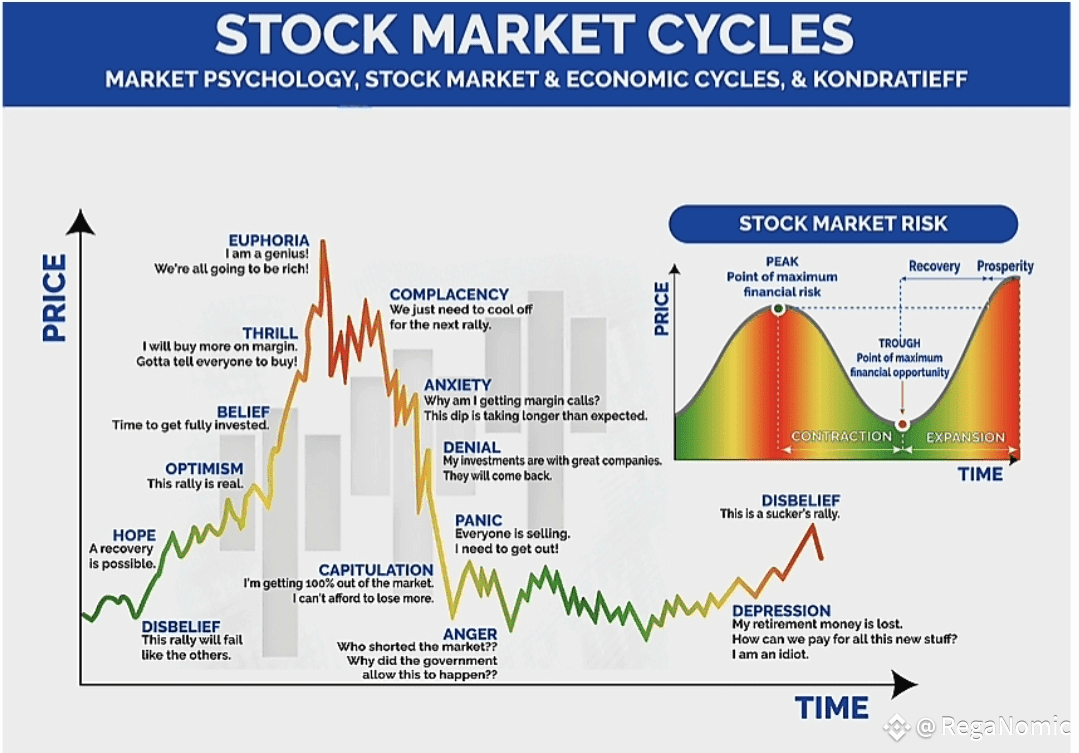Trading psychology refers to the emotional and mental patterns that influence how people behave in financial markets.
Success in trading is not just about charts or strategies — it’s about mastering your mindset. Your brain can be your greatest asset or your biggest enemy in the markets. Let’s break down the psychological side of trading in a structured, practical, and powerful way.

🔵 Section 1: Core Psychological Traps in Trading
Before You Trade the Charts, Trade Your Mind
Recognize → Disarm → Grow
1️⃣ Cognitive Biases:-
These distort rational thinking and sabotage trades:
🏹Overconfidence:
You believe you're always right → leads to ignoring signals or overtrading.
🏹Anchoring:
You cling to a specific price or past trade level → avoid adaptive thinking.
🏹Regret Aversion:
Fear of being wrong again → causes paralysis and inaction.
2️⃣ Emotional Cycles:-
Markets trigger intense feelings:
🏹Fear:
Freezes action or causes early exits.
🏹Greed:
Pushes you into big risks, missed exits, or ignoring plans.
🏹Frustration:
Triggers revenge trading or system abandonment.
3️⃣ Burnout & Obsession:-
Long-term damage often goes unnoticed:
🏹Overtrading:
Exhaustion from constant screen time and impulse-driven entries.
🏹Performance Pressure:
Obsession with results > destroys process discipline.
🟣 Section 2: Building a Psychological Trading System
Mindset Is Trainable — Build It Like a Skill, Sharpen It Like a Weapon
🪀 1. Write a Full Trading Plan
Define: Entry/exit, size, risk limits, drawdown rules.
Add filters: “No-trade zones” during emotional periods.
🪀 2. Use a Trading Journal
Log every trade with your emotions & logic behind it.
Spot repeating emotional errors (greed, FOMO, fear).
Review weekly: Reflect, learn, reset.
🪀 3. Practice Mindfulness
Pre-trade breathing: Ground your emotions.
Stay conscious of thoughts during volatility.
🪀 4. Simulate First
Trade demo accounts to master behavior.
Reinforce your discipline in different conditions.
🪀 5. Take Scheduled Breaks
Especially after wins/losses.
Reset → Return clear-minded.
🪀 6. Join Trading Communities
Share thoughts & struggles.
Gain emotional balance via feedback, accountability.
🪀 7. Process Over Outcome;
A winning process is superior to one lucky trade.
Detach from “must-win” mentality.
🟡 Section 3: Psychological Risk Management
Managing Emotional Risk in Live Markets
Emotion-Proof Your Trades.
🎯 1. Plan Risk Before Entry:
Define how much you’re mentally and financially ready to lose.
Set a max loss per trade/day/week — and follow it.
🎯 2. Trade Your Profile:
Don’t copy others. Match your trades with your personal stress limits.
Know your emotional triggers: tight SL? fast losses? heavy size?
🎯 3. Use Risk Tools to Stay Calm
SL = your emotional safety net.
TP = your clarity anchor.
RRR = your decision logic.
🎯 4. Survive First, Win Later
Your #1 goal isn’t winning every trade — it’s surviving every cycle.
Avoiding emotional blowups leads to long-term edge.
🔴 Section 4: Growth Psychology for Trader
Think in Years, Act with Daily Focus
Mindset of Consistency
🧠 1. Build Resilience / Not Ego:
You will lose. A lot. It’s part of growth.
Don’t attach your identity to a single trade.
🧠 2. Embrace Uncertainty:
No setup is 100% guaranteed.
Stay adaptive, not rigid.
🧠 3. Master Emotional Detachment
Don’t celebrate wins too hard.
Don’t mourn losses too long.
Focus on execution quality.
🧠 4. Learn From Pain, Not Regret
Losing trades are free coaching sessions.
Review → Log → Adapt → Move On.
🧠 5. Rewire Your Beliefs About Trading
It’s not about fast money.
It’s about long-term performance and personal mastery.
🟢Section 5: Deadly Trading Biases (and How They Hurt You)
Even the sharpest strategies fail if your brain betrays you. These hidden mental traps distort logic and silently sabotage your trading:
☠️ 1. Overconfidence Bias:
You think you're always right.
🔻 Danger: Oversized positions, ignoring risk, no stop-loss.
☠️ 2. Confirmation Bias:
You only seek info that supports your trade.
🔻 Danger: Ignoring red flags, poor adaptability.
☠️ 3. Anchoring Bias:
You’re stuck on a specific number or price.
🔻 Danger: Holding losses, obsessing over "break-even."
☠️ 4. Loss Aversion Bias:
You hate losing more than you love winning.
🔻 Danger: Early exits, avoiding risk, moving SL.
☠️ 5. Regret Aversion Bias:
You fear being wrong and regretting the trade.
🔻 Danger: Hesitation, missed entries, no confidence.
☠️ 6. Recency Bias:
You believe recent results will repeat.
🔻 Danger: Chasing, overtrading, trend fomo.
☠️ 7. Gambler’s Fallacy:
You think a win is “due” after losing.
🔻 Danger: Revenge trading, breaking discipline.
🔚 Final Words🔥🔥
“The market is a mirror — it reflects your inner world. Master your mind, and you master the market. Tools evolve, strategies shift — but psychology remains the ultimate battleground where real traders are made.”🎭